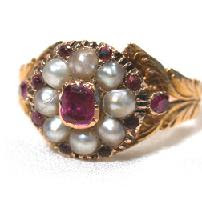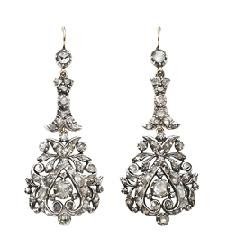I love when I have to research jewelry for a story. One of my favorite sources is Three Graces Antique Jewelry, a good place for research and fantasy shopping. Most of the images in this post are from Three Graces. I based a ring in one of my books on this one, substituting sapphires for the rubies.
I’ve also learned that for the heroine on a budget like me, there were options that were less expensive than gold and gemstones.

 I remember seeing the term “pinchbeck” in Georgette Heyer novel and wondered what it meant. It turns out it’s an alloy of copper and zinc invented by Christopher Pinchbeck (1670-1732) and used extensively to make durable jewelry that was less expensive than gold. The earrings to the left are gold, to the right, pinchbeck, both early 19th century. I think both are very pretty! One could wear these to a ball, with a pretty white gown if one were young, or with more vibrant colors if older (I love gold with green).
I remember seeing the term “pinchbeck” in Georgette Heyer novel and wondered what it meant. It turns out it’s an alloy of copper and zinc invented by Christopher Pinchbeck (1670-1732) and used extensively to make durable jewelry that was less expensive than gold. The earrings to the left are gold, to the right, pinchbeck, both early 19th century. I think both are very pretty! One could wear these to a ball, with a pretty white gown if one were young, or with more vibrant colors if older (I love gold with green).

 The term “paste” used to make me think of plastic (ugh!) but it actually refers to cut leaded glass faceted to resemble real gemstones. Being softer, it was trickier to cut. And some of it is very pretty as well. Here I have several sets of earrings, diamonds above, paste below. Frankly, I cannot tell the difference! Any of them would be just the thing for a night with my lover at the opera.
The term “paste” used to make me think of plastic (ugh!) but it actually refers to cut leaded glass faceted to resemble real gemstones. Being softer, it was trickier to cut. And some of it is very pretty as well. Here I have several sets of earrings, diamonds above, paste below. Frankly, I cannot tell the difference! Any of them would be just the thing for a night with my lover at the opera. 
 The term “parure” refers to a set of matching jewelry. The first is amethyst, the other is emerald-colored paste. I think these parures would be great for a presentation at court. Since the combination of high waists and hoop skirts couldn’t flatter any figure, pretty trinkets like this would help to bring the eye toward the face, instead.
The term “parure” refers to a set of matching jewelry. The first is amethyst, the other is emerald-colored paste. I think these parures would be great for a presentation at court. Since the combination of high waists and hoop skirts couldn’t flatter any figure, pretty trinkets like this would help to bring the eye toward the face, instead. 
Here are some more period baubles. Can you guess what period they are and can you tell the paste and pinchbeck from the real? (Don’t worry if you can’t–I was very surprised by some of them.) Where would you wear them?








Oh, Elena, HOW much more up my alley could you be?
Like you, I love the sparkles. My husband calls me a magpie also. Your pictures are gorgeous!!
Thanks for sharing.
Oooh, pretties! Those are all gorgeous. 🙂
I have a wonderful book I picked up in the Met store called “Georgian Jewelry” that has lovely color photos and a wide variety of styles and material, I look at it on depressing days to cheer myself up, LOL. (and I’m thinking of buying their “Victorian Jewlery” as well). I love stuff like this.
Wow, these are gorgeous. I own a pinchbeck locket I picked up for a song many years ago in England, but now I certainly wouldn’t be able to afford it now.
I love that ring!!!!
And the amethyst set, which is probably to matchy-matchy these days.
I can’t tell the real from the paste. I’d love the paste ones as much as the real ones.
Oh Elena what a GORGEOUS post! SIGH!! I too LOVE anything that sparkles. That amethyst set is FABULOUS !!
Like you, O Divine One, I can’t tell the difference and if I can’t tell the difference WHO CARES !!
Gorgeous stuff!
Amanda, now I have to go in search of those books!
FYI, the first set of earrings are diamond, c1790-1800. The next set, in a similar style, are Edwardian paste.
The third set of earrings are garnet and paste, c1780, and the brooch is mid-18th century garnet and half pearls set in pinchbeck. These two items show they didn’t mind mixing the “real” with the “fake”.
The last item, the multicolored “eye” brooch is paste, but I was surprised to see it dated 1790. I don’t doubt that but it looks so modern to me!
Great post. I’ve always wondered what paste jewelry looked like and was made of. It holds up pretty well next to the real thing.
Aloha, Elana! I have a small jewelry box from my English grandmother, filled with her bits and bobs. When I was a child, I thought the contents were the Crown Jewels. Even though I have discovered they are not, I still treasure them because they were hers!
Oh those emeralds! If that’s what they are. I have a real weakness for emeralds, and lost (in the garden) the only genuine one I’ve ever been given.
Oh. Oh. I want it all. All of it.
What lovely pieces and interesting post. I was familiar with most of the terms, but not pinchbeck. It is a bit sad that the “fakes” look so much like the good stuff. People have thrown, given jewelry away, or sold for next to nothing pieces that we the real thing and worth quite a bit.
I love period jewelry and pick up pieces when I can at yard sale or thrift shops. I don’t ever expect to find anything of value, but I have some pretty pieces.